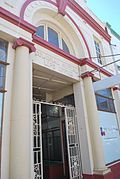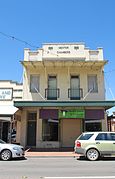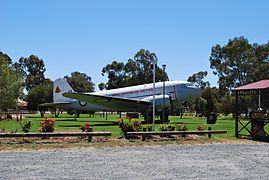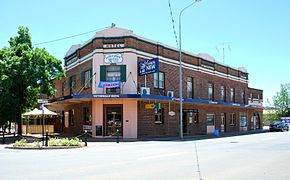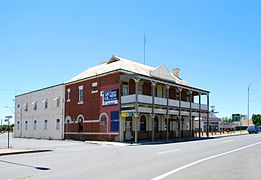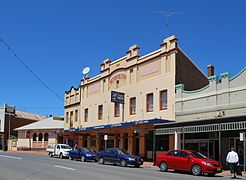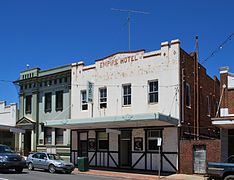world.wikisort.org - Australia
West Wyalong is the main town of the Bland Shire in the Riverina region of New South Wales, Australia.[2] Located 467 kilometres (290 mi) west of Sydney and 262 m (860 ft) above sea level, it is situated on the crossroads of the Newell Highway between Melbourne and Brisbane, and the Mid-Western Highway between Sydney and Adelaide.[3]
| West Wyalong New South Wales | |||||||||
|---|---|---|---|---|---|---|---|---|---|
 Main Street (Newell Highway) in West Wyalong | |||||||||
 West Wyalong | |||||||||
| Coordinates | 33°55′0″S 147°13′0″E | ||||||||
| Population | 2,643 (2011 census)[1] | ||||||||
| Postcode(s) | 2671 | ||||||||
| Elevation | 262 m (860 ft) | ||||||||
| Location | |||||||||
| LGA(s) | Bland Shire | ||||||||
| Region | Riverina (New South Wales) | ||||||||
| State electorate(s) | Cootamundra | ||||||||
| Federal division(s) | Riverina | ||||||||
| |||||||||
The West Wyalong district is the largest cereal-growing centre in NSW. Eucalyptus oil production started in 1907 and the West Wyalong area became one of the major world exporters of the product.

History
The Wiradjuri people were the first to inhabit this region. (Wiradjuri northern dialect pronunciation [wiraːjd̪uːraj]) or Wirraayjuurray people (Wiradjuri southern dialect pronunciation [wiraːjɟuːraj]) are a group of indigenous Australian Aboriginal people that were united by a common language, strong ties of kinship and survived as skilled hunter–fisher–gatherers in family groups or clans scattered throughout central New South Wales.
In the 21st century, major Wiradjuri groups live in Condobolin, Peak Hill, Narrandera and Griffith. There are significant populations at Wagga Wagga and Leeton and smaller groups at West Wyalong, Parkes, Dubbo, Forbes, Cootamundra, Cowra and Young.
Gold was discovered at Wyalong in September 1893 by Joseph Neeld. In 1895 West Wyalong was developed 5 kilometres (3 mi) from Wyalong around the bullock track, without the benefit of town planning, resulting in curious kinks in the road where it avoided trees. As well as the mines, the White Tank water supply was located here. This is now the location of McCann Park.[3] The goldfield was declared the most productive in the colony in 1899.[3]
As mining declined West Wyalong became the main service centre for agriculture in the surrounding district, although for many years there was rivalry between the towns. Both towns wanted the Temora railway line, but settled on a compromise of a station midway between the two towns, called Wyalong Central.
Development since the 1970s has expanded Wyalong in the direction of West Wyalong with several motels built at Central Wyalong. A shared bicycle and pedestrian track was constructed in 1994 to link Wyalong with West Wyalong.
The population has stabilised recently. This is due, in part, to the Cowal Gold Mine adjacent to Lake Cowal, 45 km northeast and Pace Farm's egg production facility.
Climate
West Wyalong has long, sweltering summers and cool winters with extended overcast periods not uncommon, typical of lower Outback New South Wales.
| Climate data for Wyalong Post Office | |||||||||||||
|---|---|---|---|---|---|---|---|---|---|---|---|---|---|
| Month | Jan | Feb | Mar | Apr | May | Jun | Jul | Aug | Sep | Oct | Nov | Dec | Year |
| Record high °C (°F) | 45.3 (113.5) |
44.8 (112.6) |
40.6 (105.1) |
36.2 (97.2) |
28.3 (82.9) |
24.2 (75.6) |
25.5 (77.9) |
28.4 (83.1) |
34.4 (93.9) |
37.6 (99.7) |
42.2 (108.0) |
43.6 (110.5) |
45.3 (113.5) |
| Average high °C (°F) | 32.9 (91.2) |
31.9 (89.4) |
28.7 (83.7) |
23.7 (74.7) |
18.7 (65.7) |
14.9 (58.8) |
14.1 (57.4) |
16.0 (60.8) |
19.6 (67.3) |
23.5 (74.3) |
27.3 (81.1) |
30.7 (87.3) |
23.5 (74.3) |
| Average low °C (°F) | 17.6 (63.7) |
17.5 (63.5) |
14.5 (58.1) |
10.0 (50.0) |
6.8 (44.2) |
4.2 (39.6) |
3.0 (37.4) |
3.9 (39.0) |
6.2 (43.2) |
9.4 (48.9) |
12.6 (54.7) |
15.4 (59.7) |
10.1 (50.2) |
| Record low °C (°F) | 6.7 (44.1) |
8.2 (46.8) |
5.0 (41.0) |
−1.1 (30.0) |
−3.0 (26.6) |
−4.5 (23.9) |
−5.0 (23.0) |
−4.5 (23.9) |
−3.0 (26.6) |
1.1 (34.0) |
2.5 (36.5) |
6.2 (43.2) |
−5.0 (23.0) |
| Average precipitation mm (inches) | 42.7 (1.68) |
39.2 (1.54) |
39.8 (1.57) |
34.5 (1.36) |
38.6 (1.52) |
43.4 (1.71) |
41.8 (1.65) |
38.5 (1.52) |
37.0 (1.46) |
44.6 (1.76) |
37.5 (1.48) |
43.8 (1.72) |
481.4 (18.97) |
| Average precipitation days (≥ 0.2 mm) | 4.9 | 4.6 | 4.8 | 4.7 | 6.6 | 8.6 | 9.8 | 9.0 | 7.2 | 6.9 | 5.7 | 5.4 | 78.2 |
| Source: Australian Bureau of Meteorology; Wyalong Post Office | |||||||||||||
Places of interest
- The Poppet Head
- Lions Park Dakota DC3
- West Wyalong Museum
- West Wyalong Airport
- Easel sculpture of West Wyalong (Drysdale)
- Wyalong Wetlands
- Tivoli Theatre
Schools
- St Mary's War Memorial Catholic School (K-6) - The original St. Mary's Church School was built in 1901 of corrugated iron and staffed by the Sisters of Mercy. By 1903 there were 167 students. The present St. Mary's School was built in 1961.
- West Wyalong Primary School (K-6)
- West Wyalong High School (7-12)
- Wyalong Public School (K-6)
Pubs and clubs in West Wyalong

- The Tattersalls Hotel
- The Metropolitan Hotel
- Royal Hotel
- The White Tank Hotel
- West Wyalong Services & Citizens Club
- West Wyalong Lawn Bowling Club
- West Wyalong Golf Club
- Toppy Pub (Wyalong)
Sport
The most popular sport in West Wyalong is rugby league. The town's rugby league team competed in the Maher Cup.
- West Wyalong Wildcats - (basketball)
- West Wyalong Mallee Men - rugby league
- West Wyalong-Girral Bulldogs - Australian rules football & netball
- West Wyalong Weevils - senior rugby union
- West Wyalong Pirates - junior rugby union
- Alleena Cricket Club - cricket
- Tallimba Cricket Club - cricket
- White Tank Cricket Club - cricket
Annual Shows and Events
January
- Australia Day Breakfast and Awards (26th), West Wyalong[4]
- David Earl Memorial Cricket Match, West Wyalong[4]
February
- Pancake Breakfast, West Wyalong[4]
- West Wyalong Rugby League Knockout (Last Fri./Sat.)[4]
- Dean Wood Big Gig
March
April
- ANZAC Day Celebrations (25th)[4]
- Wellness West Wyalong Festival[4]
- Ladies Day Out in West Wyalong[4]
May
- Mother's Day Luncheon (2nd Sun.), West Wyalong[4]
- Masonic Debutante Ball (2nd Sat.), West Wyalong[4]
July
- Catholic Debutante Ball, West Wyalong[4]
August
September
- Barmedman Show & Beaut-Ute Comp. (1st Sat./Sun.)[4]
- West Wyalong Show (1st Wed.)[4]
- Ungarie Show (2nd Fri.)[4]
- West Wyalong Charity Campdraft[4]
October
- Mirrool Silo Kick Challenge (2nd Sat.)[4]
- 'in the West' Festival www.inthewest.com.au[4]
November
- Early Markets (1st Sat.), Wyalong[4]
December
- Christmas Market/Carols by Candlelight, West Wyalong[4]
- New year Celebrations & Bi-annual Fireworks, West Wyalong[4]
Notable people from the area
- Dymphna Cusack, author[3]
- Reginald Roy Rattey, Victoria Cross recipient
- Terry Gathercole, champion swimmer
- Mark O'Meley, rugby league footballer
- Scott Staniforth, rugby union footballer
- Mat McLachlan, author and historian
- Anthony Gelling, rugby union representatives
- Neale Daniher AM, former AFL footballer, former AFL coach and motor neurone disease campaigner
- Terry Daniher, former AFL footballer
- Anthony Daniher, former AFL footballer
- Chris Daniher, former AFL footballer
- Dal Stivens, author - grew up in the town
- Danny Meagher, Catholic bishop
Gallery
- Aboriginal Artifacts Store
- Ambulance Station
- West Wyalong Anglican Church
- Bank of New South Wales
- Bland Shire Council Offices
- Colonial Mutual
- Commercial Bank of Australia
- Commercial Bank of Australia
- Commonwealth Bank
- Court House
- CWA Hall
- Elders Office
- West Wyalong Federation House
- Houses & Church
- Leadbetter Motor Garage
- Main Street
- Medical Hall
- Mentor Chambers
- West Wyalong Police Station
- West Wyalong Presbyterian Church
- West Wyalong Presbyterian Manse
- RAAF Plane
- West Wyalong Roman Catholic Church
- West Wyalong Post Office
- West Wyalong Rural Bank
- West Wyalong Rural Bank
- Main Street
- Thom's Corner
- Memorial Literary Institute
- Tattersalls Hotel
- White Tank Hotel
- Royal Hotel
- Post Office Hotel
- Metropolitan Hotel
- Globe Hotel
- Empire Hotel
Media
The West Wyalong Advocate newspaper is an independent publication,[5] printed on Fridays. It also services nearby towns including Ungarie and Barmedman.
94.5 GOLD FM is West Wyalong's community radio station.[6] It is an independent not-for-profit community broadcaster founded in 2001.
West Wyalong Movies is a project by Ross Harmer aimed at documenting the history of West Wyalong and The Bland Shire.[7]
Surrounding towns
| • Barmedman | (32 km or 20 mi) |
| • Burcher | (52 km or 32 mi) |
| • Tallimba | (34 km or 21 mi) |
| • Ungarie | (42 km or 26 mi) |
| • Weethalle | (57 km or 35 mi) |
| • Wyalong | (3.5 km or 2.2 mi) |
References
- Australian Bureau of Statistics (31 October 2012). "West Wyalong (Urban Centre/Locality)". 2011 Census QuickStats. Retrieved 10 April 2014.
- "Archived copy". Archived from the original on 17 September 2006. Retrieved 16 January 2007.
{{cite web}}: CS1 maint: archived copy as title (link) - Dow L, Guyon D, Irving R, McPhee M, Matthews A, Prineas P, Rubinich T, Simpson J (1995). Reader's Digest Illustrated Guide to Australian Places. Surry Hills, NSW: Reader's Digest. p. 227. ISBN 0-86438-399-1.
- West Wyalong NSW find hearts of gold. West Wyalong: Bland Shire Council. 2012. p. 11.
- "Members | Country Press New South Wales Inc. | Australia's oldest newspaper industry association Founded 1900". www.cpnsw.org.au. Retrieved 1 August 2022.
- "94.5 GOLD FM website". Retrieved 1 August 2022.
- "West Wyalong Movies bringing local history to life". Retrieved 28 December 2016.
External links
![]() Media related to West Wyalong at Wikimedia Commons
Media related to West Wyalong at Wikimedia Commons
На других языках
[de] West Wyalong
West Wyalong ist eine Stadt mit etwa 2.700 Einwohnern[2] im Zentrum des australischen Bundesstaat New South Wales. Sie liegt 467 Kilometer westlich von Sydney, an der Kreuzung des Newell Highway, zwischen Melbourne und Brisbane, mit dem Mid Western Highway zwischen Sydney und Adelaide. Die Stadt ist der Verwaltungssitz des Verwaltungsgebiets (LGA) Bland Shire.- [en] West Wyalong
Другой контент может иметь иную лицензию. Перед использованием материалов сайта WikiSort.org внимательно изучите правила лицензирования конкретных элементов наполнения сайта.
WikiSort.org - проект по пересортировке и дополнению контента Википедии





